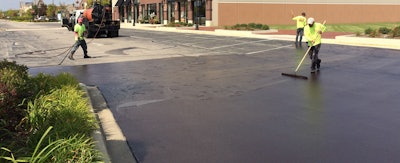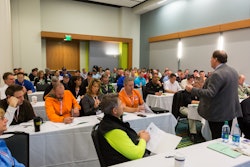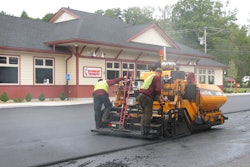
Sealcoating can help your paving business stand out in more ways than one. Of course, there is the obvious surface transformation of a job well executed. But, the differentiation of your business really begins in the sales process; in fact, with each interaction, most property managers are seeking your expertise. After decades of working closely with property owners and managers, I have listened closely to their issues. While some understand sealcoating is an important part of an effective pavement maintenance plan, many still have misconceptions and concerns about what sealcoating can and cannot do. That is where you come in. When you get in front of a property manager, it is essential to thoroughly and accurately inform your client about what services you will provide and products you will use on the job so there are clear expectations. Also, let the property manager know what to expect both in the long and short term after you complete the job. Your level of knowledge and detailed explanations will build trust and credibility, alleviate most “call back” situations, and help you earn repeat business and referrals. In order to differentiate yourself, it is important for you to be seen as a knowledgeable professional, in what may be perceived as an unprofessional trade, by the end user.
Setting the Right Expectations
Start by distinguishing what a sealer can do and what it cannot do. Generally speaking, the purpose of sealcoating is to slow the rate of pavement deterioration, which helps extend the service life of the pavement and saves money over time while also enhancing curb appeal (aesthetics).
When asphalt is exposed to UV sunlight, moisture, and air, the asphalt bitumen oxidizes and strips away, releasing the aggregate in a process known as raveling. In addition, fluids from cars–petroleum based oils and gasoline–work to dissolve the unprotected asphalt bitumen when it comes in contact with the pavement. Left untreated, these conditions will shorten the life of the asphalt pavement. Sealcoating can stop that downward cycle by providing a protective barrier against UV sunlight, water, air, chemicals, salt, oils, and gasoline.
Sealcoating can fill hairline cracks; but, it is not a substitute for crack filler or crack sealer which should be placed on wider cracks. Further, sealcoat is not a structural remedy for pavement defects; it cannot prevent cracking caused by poor design, improper construction, or fatigue. It cannot restore a worn out pavement or cure defects in the base, sub-base, or mix design of the asphalt. Neither can it remedy poor placement or workmanship. Simply put, pavement sealer helps extend the life of asphalt pavements that are in good condition compared with those left exposed to environmental elements and petroleum fluids. Many managers and property owners do not know these facts regarding asphalt and pavement maintenance. Almost always, this line of conversation generates more questions and, thus, begins the education process.
Be Prepared to Explain and Distinguish Product Choices
Today there are more pavement sealer choices than a decade ago. You will likely find your prospective client has more than one proposal offering different sealer options. For example, most manufacturers make various types of pavement sealer, both refined tar and asphalt based, and each type can be polymer modified or non-modified.
Most property managers do not understand the differences of each and their advantages or limitations. Some may have heard recently that refined tar sealers have come under regulatory scrutiny (despite a growing body of science which supports their safe use) and in some places have been banned from use. Therefore, it is incumbent upon you to help educate on the pros and cons of using a refined tar sealer (still the most commonly used in most markets, especially east of the Rockies) and determine whether it is the proper choice or if an alternative product, such as asphalt or petroleum emulsion sealer, may be better suited for the job.
So, what does a contractor need to know about sealer types? Refined tar, in contrast to asphalt bitumen, is slower to oxidize, which gives it a distinct advantage in longer-lasting protection against the elements (water, UV sunlight, air) and resistance to fading when compared to its asphalt-based cousin. Refined tar is also resistant to petroleum fluids (gasoline, diesel, motor, and transmission oil) that readily soften and dissolve the asphalt bitumen that binds the aggregate together. This is because asphalt bitumen is the heaviest of petroleum derivatives produced from the same crude oil that produces the lighter distillates of gasoline, diesel, and fractions for auto lubricants. The lighter petroleum fluids dissolve the heavier ones when they come in contact with each other, causing the asphalt bitumen to lose cohesive integrity and start to ravel. Because of its unique properties, refined tar sealer offers better protection against these common detractors. However, the economic availability of refined tar is limited to the eastern and Midwest US because refined tar production is confined to five producers located in the eastern US and southeastern Canada. For logistical reasons, this makes refined tar sealer too costly to produce in or deliver to western states. In contrast, asphalt bitumen is widely available across the US, which makes asphalt-based sealer available throughout the country. Though not fuel resistant or as durable as refined tar, it provides protection in a similar way that adds value by extending the service life of asphalt pavements.
In addition to refined tar and asphalt emulsion sealers, there are other premium, enhanced, polymer-modified versions of each type. Worth noting is that while premium grades cost more up front, they are more cost-effective in the long term and more beneficial to the property manager’s bottom line. Consider, for example, a multi-tenant retail shopping center. Property managers state that sealcoating is the most disruptive activity to the business of their tenants. Offering a polymer-modified, higher-performing pavement sealer may cost 15-20% more to the property manager on the front end but can add 50-65% longer life than conventional non-modified sealers on the back end. This reduces the frequency of sealcoating applications to the parking lot and means fewer disruptions to the tenants while lowering annualized maintenance cost over the life of the pavement to the owner. In offering this as an option, you are providing your client with a better choice that provides greater value in the long term while potentially earning a higher margin for yourself. You also differentiate your bid from competitors who may offer only one choice.
Finally, many of your clients may inquire about recent bans of refined tar sealers, so be prepared to discuss where those bans have occurred. Refined tar sealers are banned in two states (Washington, where refined tar sealers were not widely used prior to the ban, and Minnesota) and a handful of cities and counties (Austin; Madison; Suffolk County NY (Long Island); Montgomery and Prince George’s County, MD; Winnetka, IL; Edwards Aquifer, TX; and Washington, DC primarily). Contrary to popular belief, refined tar sealer is not banned in California. In short, there are only a few areas that have instituted bans, so this sealer can still be safely used in most places. For more information about refined tar and its regulatory status, visit www.pavementcouncil.org.
Mix Design: It Really Does Matter
Mix design has a major impact on sealer performance. It is important to explain the significance of this, especially in today’s market where there are many choices of pavement sealer. While mix design does not vary widely among refined tar sealers that meet the federal specification, mix designs vary widely among asphalt-based sealers and premium polymer-modified grades. This is because Fed Spec refined tar sealer, in order to be called such, must conform to an age-old government specification that was once known as RP-355e, or “Federal Grade.” Established by the federal government’s General Services Administration decades ago, the specification is now governed by ASTM D5727. It is an industry-accepted standard recognized by sealer manufacturers. To date, no industry-accepted standard has been adopted for asphalt-based sealer. Therefore, each manufacturer makes asphalt-based sealer according to their own recipe specification. The same holds true for each manufacturer’s “premium performance” grade of sealer. This is not an indication that non-refined tar sealers are inadequate. However, each of these differing “flavors” of pavement sealers will have different mix designs with regard to water dilution, recommended additives (if required), amount to be used, and sand loading.
Make sure your client understands the mix design you use for the sealer type you are recommending and show that it conforms to the manufacturer’s recommended mix design. Stipulate the mix design in your proposal and attach a copy of the manufacturer’s application specification. Your proposal is likely to gain more attention and generate questions that your competitor cannot adequately answer. If the mix design calls for additives, explain the purpose for each admixture. For example, latex additives are used to improve the overall performance of sealer. Some are designed to increase internal strength of the cured film which reduces wheel scarring and sand rollout. With the right additive, you can add the proper amount of sand to improve slip resistance and improve film strength. Other additives are designed to promote faster curing and improved color.1
The bottom line is that a proper mix design needs to accommodate the type of sealer used on the job and address the condition of the pavement. Ultimately, whichever product and/or additives you specify for a client, be sure to explain why you recommend it and its benefits on the job. Again, this will differentiate you from most other bidders.
Expectations...Check! Materials...Check! Next Comes Proper Application
“Mr. Contractor, my new parking lot is ready to be sealed…let’s get started!” Well, actually, proper application starts with accurate timing. The optimum time to seal new asphalt is when it has cured long enough to build up its resistance to deformation and degradation. This may take up to a year under normal weather conditions and normal traffic loading. Most sealer manufacturers’ specifications state that new asphalt will cure in 30-90 days. In general, this cure time will be enough to enable sealer to bond to the surface of a new pavement. But the pavement still may not have reached optimum stability and can be tender especially in high-temperature conditions. Sealcoating over a pavement too early prevents new asphalt from curing to the point where it has stabilized enough to withstand vehicular deformation. It makes the pavement surface very susceptible to damage from hard-turning vehicles. Sealing too early also creates higher probability of surface cracking. Data from two long-term studies conducted by PCTC support these two conclusions.2 According to the studies, test strips sealed with standard mix designs over new asphalt one year after placement exhibited good durability after three years with zero surface cracks. Test strips that were sealed 30 and 45 days after new pavement placement showed surface cracking one to two years later. Pavements should be sealed one to three years after construction. Thereafter, the process should repeat when asphalt re-exposes itself as sealer slowly wears away. Frequency largely depends on the traffic load. A retail center with a major anchor tenant will have a shorter reapplication cycle than a church. Lead your client to think “long term” and to follow a regular maintenance plan with high-quality materials to maximize savings. Offer to develop the plan for them.
Whether you use a squeegee, broom, or spray to apply sealer, educate your client about the pros and cons of your equipment and the application process. Squeegee application is more time consuming but viewed as a more durable finish. In most cases, it consumes more sealer per square foot, particularly if the pavement surface is rough in surface texture. It does an excellent job in filling surface voids in the pavement. Aesthetically, it tends to leave behind squeegee marks and sand streaks. In contrast, the spray method applies sealer evenly over the entire surface. It is easier to control material yield and there are no squeegee marks or streaks. With either method, uniform coverage is key, and the first coat should be left to dry for at least four hours minimum under ideal weather conditions before a second coat is applied. Oftentimes a first coat squeegee followed with a second coat spray is specified. The best method is always a subject of debate among contractors and this article does not attempt to take a side. Nevertheless, either method is acceptable and you should identify in your proposal which method you intend to use and distinguish why. Two coats of sealer are standard and recommended in all manufacturers’ specifications for an effective seal. For high-traffic parking lots, some manufacturers recommend a third coat. You might choose to offer an option for a third coat in a high-traffic scenario while your competition is bidding only two coats (or in some cases, only one). Also consider offering an option for a third coat in high-traffic areas while providing a bid for a standard two-coat application.
How long should the parking lot stay closed? This is usually a fluid decision to be made between contractor and property manager. The property manager represents the tenants (as well as the owner) and sealcoating is disruptive to their businesses. They need it opened now! But the limitations of the sealer (both asphalt and refined tar based) require time under ideal weather conditions to properly set, dry, and cure. Opening the parking area too soon after application has definite consequences that negatively impact its long- and short-term performance. It is hard to quantify the degree of the adverse consequences, but performance is impaired when the parking lot is opened too early. Here, you should inform the property manager of the potential ramifications if they push you to open too soon. State it plainly in your proposal so that the responsibility for those ramifications falls upon your client and is documented.
One of the most common areas of misunderstanding among property managers is the difference between drying and curing. In simple terms, the process has three steps: dry, initial cure, and final cure. “Dry” occurs when the sealer film is completely dry to the touch. Sealer can be dry-to-the-touch in under an hour in some cases when the weather is warm and sunny with low humidity, but two to four hours is more typical. A “dry” coating remains susceptible to re-emulsifying when water comes in contract with it too early (by rain or sprinklers). “Initial Cure” occurs 24 hours after the last coat is applied and ideal weather conditions remain in place. Ideal weather conditions are air temperatures at or above 70 degrees Fahrenheit, full sunshine, and humidity at or below 60%. It is at this stage when the coating properly sets up and dries long enough to establish a bond strong enough to resist water. The “Final Cure” may take as long as three to four weeks. The pavement will certainly be open to traffic during this final curing period, and it will likely show some wheel scarring from hard turns and power steering pivots. That’s because the sealer has light volatile organic compounds that are “breathing off” out of the film. When that process is complete, the sealer binder hardens and becomes resistant to stresses from wheeled traffic. When the film has fully cured, it no longer scars. When the final cure is achieved, you will notice a significant drop in the residual odor of a freshly sealed parking lot. The odor comes from the volatile organics breathing off. Of the three conditions for ideal weather conditions (warm temperature, sunlight, and humidity), low humidity is the best condition for fast drying and hard cure for any pavement sealer. If you have low humidity, the pavement sealer will cure harder and quicker, even if the temperature is lower than 70 degrees Fahrenheit.
Stand Apart from the Crowd: Be the Knowledgable Resource for your Clients
Now that you have reviewed the procedure, products, and application methods, be sure to address what happens after the job is complete and the parking lot has been re-opened to traffic. Potential conversations include:
“Mr. Property Owner, it is normal to see some minor wheel scarring for a week or two especially in the hotter part of the day. But I assure you this condition will decrease with each passing day until the coating reaches final cure.”
“Ms. Property Manager, you might notice some sand accumulation in the low spots of the parking lot. This is caused by some of the sand rolling out of the dried film from traffic. It will subside once the coating reaches final cure.”
In both situations, you are pre-empting a potential call back or complaint by explaining to your client in advance what to expect. When they see the condition you have described, they will not be alarmed. You can gain their trust and become a credible partner in their eyes. It might enable you to overcome a lower bid by your competitor or tip the scale in your favor if the bids are equal.
Thorough, Accurate Communication Wins More Work
Property managers have a lot on their plates. While we live in a world focused on pavement maintenance, they also have to worry about roofs, HVAC, landscaping, painting, angry tenants, and many other issues. Of all the parts that make up a functioning property, your client likely knows least about the parking lot. Property managers rely on contractors to help them put the pieces together so they can make the right decisions concerning upkeep of their pavement assets. Unfortunately, there will always be a few contractors who misinform purposely or accidentally, and there will always be end users who will view your service as just a commodity. Properly educating your clients by providing accurate, experienced-based information can make them choose you over less-qualified competitors. Submit your bid and offer upgrade options, explaining the advantages of each choice. Specify brand, mix design, application technique, amount to be applied, and include manufacturers’ application specifications. Define what the performance expectations are and any limitations given the pavement condition. Explain clearly the potential consequences if your instructions are not followed or if the end user places limitations upon the project that contradict the guideline specification. It is important that you and the end user have equal and clear understanding of expectations in order to avoid unneeded conflict. If you always keep it professional with clear facts, you can be recognized as the expert, which results in more work and business growth.
FOR ADDITIONAL REFERENCE:
1 http://www.pavementcouncil.org/how-to-design-as-successful-pavement-sealer/
2 http://www.pavementcouncil.org/pctc-field-testing-how-soon-should-a-pavement-be-sealed/


![Lee Boy Facility 2025 17 Use[16]](https://img.forconstructionpros.com/mindful/acbm/workspaces/default/uploads/2025/09/leeboy-facility-2025-17-use16.AbONDzEzbV.jpg?auto=format%2Ccompress&fit=crop&h=100&q=70&w=100)








![Lee Boy Facility 2025 17 Use[16]](https://img.forconstructionpros.com/mindful/acbm/workspaces/default/uploads/2025/09/leeboy-facility-2025-17-use16.AbONDzEzbV.jpg?ar=16%3A9&auto=format%2Ccompress&fit=crop&h=135&q=70&w=240)








